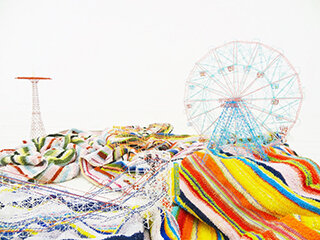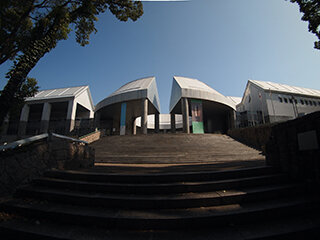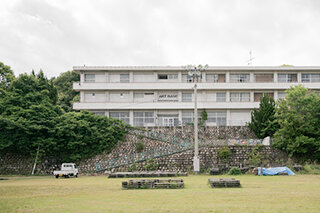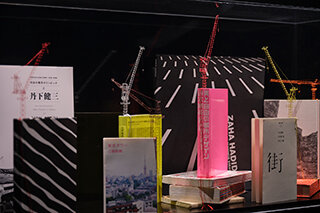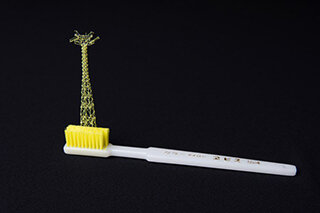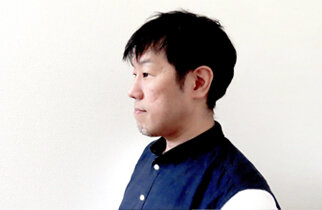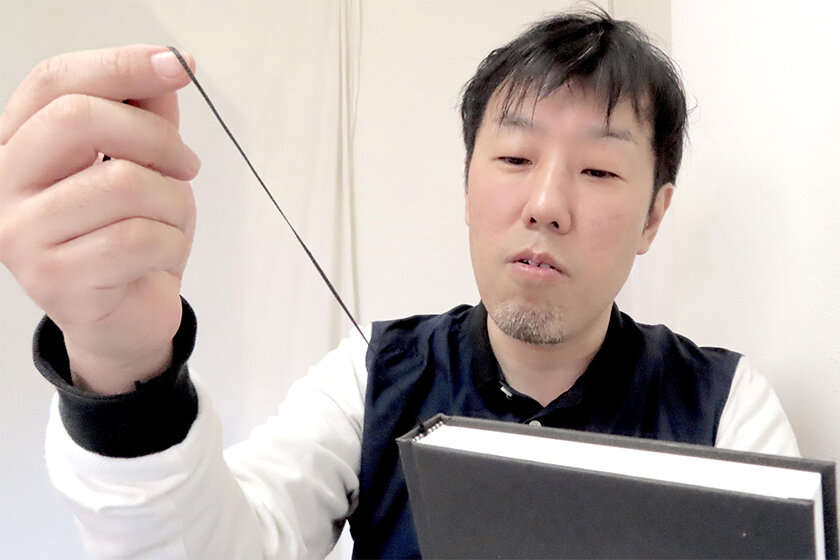


INTERVIEW
125
Takahiro IwasakiArtist
Exploring the Whereabouts of Everyday Items that Represent a City
Art rooted in location reveals a macro urban space
The artist Takahiro Iwasaki creates overlooking views of cities using everyday items around us, such as toothbrushes, towels, duct tape, bookmarkers, and mechanical pencil lead. A seemingly random pile of towels may have a steel lattice tower standing on top, or a cluster of skyscraper-like books might have delicate cranes stretching up from between them toward the sky. His art challenges our perceptions with the view from a bird’s eye as well as from an insect’s, two different scales of perspective that capture and present both the fundamental essence of a subject as well as an overall perspective. Given Iwasaki's unique sense of perspective, we interviewed him on how Tokyo and his hometown of Hiroshima appear in his eyes, as well as the urban landscapes he envisions beyond the current coronavirus pandemic.
An overhead perspective of cities gained through Hiroshima's experience with the atomic bomb
The reason I work with city landscapes in my art is largely due to the history of Hiroshima, which is my hometown and base of operation. 76 years ago, the atomic bomb and its micro-scale uranium atoms exploded 500 meters over Hiroshima, instantly decimating not only the city on a macro level, but also the large-scale timeline of all of its local history. That's the kind of city we grew up in. That's like living in the world of Neon Genesis Evangelion after the Second Impact or in AKIRA's Neo Tokyo, the post-apocalyptic city built on the ruins of Tokyo. To put it simply, we live in a city that went through a huge catastrophe before we were born. That's why to me, cities always feel a bit like dioramas--fragile spaces that could disappear in a split instant. That's true for all cities that have employed the constant "scrap and build" style of development ever since Japan's period of high economic growth, and I can't help but feel that they have a fragile, transient nature.
When I was in elementary school, I was scared of airplanes flying overhead. I was worried that another atomic bomb would be dropped on us. I wasn't the only one. My classmates said similar things. Every child who goes to school in Hiroshima receives peace education, and the image of an airplane zooming in overhead on August 6th at 8:15 and dropping the atomic bomb on us has been engrained in our minds, over and over, through anime, TV dramas, novels, and other sources. It's the image of a clear blue sky, the silver glint of a plane, instantly followed by everything going white. When I was a kid, Hiroshima Airport was still located in Hiroshima City and airplanes flew over the elementary school all the time. I hated that, and the fear that "Oh, I might be gone in the next moment" felt very real to me. That's part of why I insist on a view of cities from the sky, to simulate the experience of looking down from overhead. Perhaps I wouldn't go so far as to call it trauma, but I inevitably developed that kind of perspective as a child. I think my fear of the fragility of cities is in part rooted in those experiences.
That's why it was such a shock going to Kyoto on an expedition to study antique art during my university days. Standing before buildings that had stood there for hundreds of years, breathing in the smell of history and culture for the first time, I thought, "Wow, I never knew such a world even existed." I also studied abroad in Edinburgh, a city in Scotland that has been around for 500 years. The city itself is registered as a UNESCO World Heritage Site. That cityscape was also a huge shock for me. It forced me to see just how much the hometown I grew up in felt like a plastic model.
Everyday items as materials that represent cities
I regularly use everyday items such as toothbrushes and towels in my art such as with my Out of Disorder series, and this also has to do with my hometown of Hiroshima. The Hiroshima City Museum of Contemporary Art didn't open until I was in middle school, so the go-to museum before then was the Hiroshima Peace Memorial Museum. Most of what is displayed there are everyday items, such as ragged clothes, charred bento boxes... The remnants of a city that was utterly decimated. The Peace Museum presents these everyday items as representations of the entire city. There are other things as well: a wall stained with streaks of black rain, the image of soot from burning houses mixing with rain to create a torrent of black lines... That kind of thing, where familiar things take on something out of the ordinary, really stuck with me at the time.
Out of Disorder
Iwasaki's most iconic series that makes use of towel fibers, brush bristles, and other everyday items as material in making diorama-sized scenes of huge structures such as steel lattice towers, overhead power lines, and steel frame constructions.
2012
©Takahiro Iwasaki, Courtesy of ANOMALY
Hiroshima City Museum of Contemporary Art
Opened in 1989 as the first public museum of contemporary art in Japan. The museum puts on special rotating exhibitions as well as themed exhibitions showcasing selections from the museum's collection of more than 16,000 pieces of art. The building was designed by renowned architect Kisho Kurokawa. The museum is currently closed for renovations and is scheduled to reopen March 2023.
I started using a lot of everyday items in my work after I studied overseas in Edinburgh, partly because I didn't have a lot of money at the time. I was really poor and couldn't afford to buy material. I'd think, "Cardstock costs a whole 200 yen. I could buy jam with that money," and end up buying jam (laughs). So, I started making art with flyers I had at home and things like rubber bands and cigarette packages I found on the road. Thinking it over, I came to the conclusion that a cigarette package cut open is basically cardstock, right?
My father ran a family-operated cake shop, and there was a clothing store right across from it. Clothing stores regularly have lots of cardstock trash, and my mother got hold of a whole bunch at some point and gave them to me so that I could make things with them. For the longest time I made robots and stuff by myself, but when I showed my creations to a friend for the very first time in middle school, the friend said, "You're making dirty junk without even bothering to buy materials?" I was devastated and threw away everything I had made up to that point. I think partly because I majored in design, I was taught in university that artwork was supposed to look "neat and perfect." But when I studied abroad in Edinburgh, the people there were much more nonchalant, and didn't care if tape was sticking out or if glue went outside the lines. Seeing that reminded me of how I used to make robots whatever way I wanted when I was in elementary or middle school. I wondered why I had stopped doing that, and I envied the way the students in Edinburgh worked. That experience helped me return to creating things using everyday items.

Pride for my hometown resulted in originality
I am based in Hiroshima for several reasons, including financial considerations and my personal identity. Of course, a part of me wanted to go off to a big city like Tokyo, but you need to earn a sizable amount of money just to live through a day there. I figured it would make more sense to live somewhere with minimum costs and enjoy a life of scavenging trash to make art. That's why when I decided that I wasn't going to work for the sake of money, my hometown of Hiroshima was a key choice as a place with low running costs.
I'd like to also note that the people of Edinburgh, which is the capital of Scotland, generally don't like England (laughs). Initially, I wondered why they didn't go off to make art in London, but they have pride in their homeland as Scottish artists, with an attitude that's like, "We're not interested at all in London because we have our own history and our own art." Seeing that, I thought that instead of going off to a big city, it was more important to think about how to inherit and pass on the culture of where you were born and grew up. I also thought that once I moved to Tokyo, I would have to compete restrained by the same motifs and conditions as the people around me. But maybe if the process I used was different from others in some way, the resulting artwork would be inherently different. I thought that changing the fundamental premise would inevitably result in a kind of originality.
Still, big cities like Tokyo are overflowing with talent, so there's always a lingering sense of envy. But I also think it's a double-edged sword, because while getting inspired by talented people is a big plus, the city has its fair share of risks. The turnaround of talent is very fast, so people can forget you quickly for the sake of something new, or you could meet someone with so much more talent that you're intimidated into giving up on art altogether. That's why in my case, I find it best to only go sometimes to get some occasional inspiration.
(The images here were taken during our online interview.)
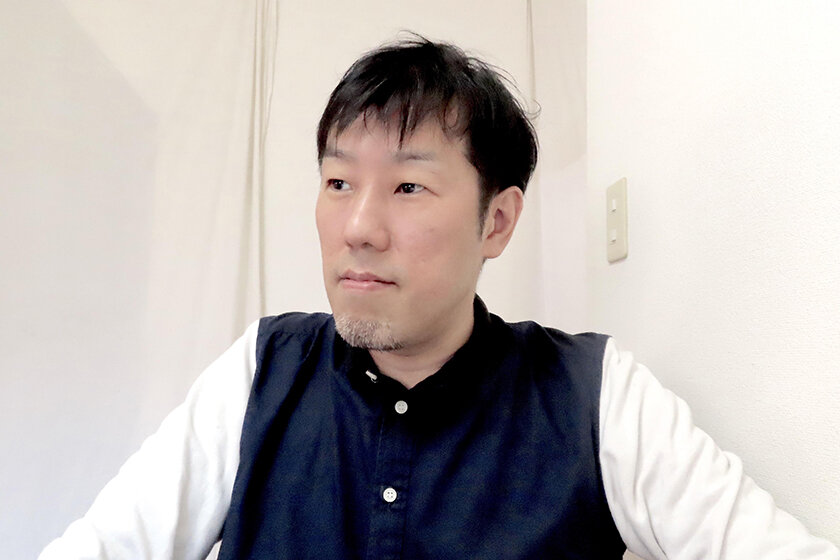
Tokyo's identity changes with its billboards
When I compare Tokyo and Edinburgh, Edinburgh is distinct in that most of the city forbids the use of ads and billboards. It looks the same whenever you go, which some people may imagine to be boring. Meanwhile, Tokyo is flooded with billboards everywhere, and because these things change periodically, the view and feel of the city itself changes with them significantly. When I went to Shibuya the other day, I saw that the place I remembered as a FOREVER 21 was taken over by a huge IKEA sign, and that was enough to make the city of Shibuya look different. Originally, that location had been an HMV when I was in high school, giving me the impression that Shibuya was an edgy town, and it's strange to think that now it's a town that sells furniture (laughs). I think that's a good example of how a change in the "graphical interface" of a city doesn't just change the impression it gives, but can potentially change its very identity.
My impression of Roppongi is that it's a district where museums and galleries gather. Personally, I'm very sad that the Aoyama Book Center is gone. There are not a lot of bookstores in Hiroshima that sell foreign books and books on art, so checking out bookstores when visiting Tokyo was a pretty important thing for me. I even went to Roppongi sometimes just to visit the Aoyama Book Center, and that was one of the appeals of going to Roppongi for me.
Now is the time for us all to put our heads together
To answer the question of how I think cities and people will change having gone through the pandemic, I don't really know because I'm not a sociologist. The virus itself is mutating and political stuff always fluctuates, so I think things will just naturally turn out the way they're going to. But there is one thing I want people to push for given the situation, and that is to decentralize things. I want them to send back more talented people from Tokyo to other areas. I want lots of people who have studied in Tokyo to come to Hiroshima, as well as to Yamaguchi, Okayama, Tottori, and Shimane. I'm sure remote working styles including the use of virtual reality technology will become more prevalent as time goes on. That's particularly why I think this is a great opportunity for talented people to leave Tokyo and work wherever they want, so I would want the government to come up with a plan to accelerate that. Then exhibitions wouldn't have to be concentrated in Tokyo. Wouldn't it be interesting to have exhibitions you want to go to dispersed all around the country?
Right now a lot of areas, Hiroshima included, are requesting for people not to come in from other places. At least until the pandemic is over, perhaps it's time for each region to develop their own cultural enjoyments solely within that area, such as Hiroshima culture in Hiroshima and Iwate culture in Iwate. Then by the time people are free to travel to Japan from overseas, I would love to see cultural appeal dispersed throughout the country, helping to increase the appeal of Japan as a whole. There are artists everywhere, and artists have the freedom to move to any location they find appealing. That's why I think it would be interesting to have coordinators, curators and gallerist--the people who support the infrastructure of art--scattered throughout the regions. Young artists are quick to spread the word about an interesting curator, after all (laughs). I think those people have very diverse networks, of artists and otherwise, that they could take with them to other regions. I think the important thing is to start a movement to bring Tokyo networks to other regions.
ART BASE MOMOSHIMA
An art center established in 2012 in an abandoned school building on Momoshima, a small island that is part of Onomichi City in Hiroshima Prefecture. Overseen by contemporary artist and museum director Yukinori Yanagi, the center holds exhibitions and workshops to revitalize the area. Iwasaki's Out of Disorder (everything is constantly changing) is on permanent exhibit there. Hiroshima has numerous other art-related projects and facilities that make use of port warehouses and empty houses.
From the end of last year to this year, I put on a solo exhibition entitled FOCAL DISTANCE in Shibuya Scramble Square's SHIBUYA SKY. When I finished setting up in the early hours of the morning, I saw Mount Fuji from the venue's empty observation deck. I never thought such a clear view of Mount Fuji was possible from the center of Shibuya, and it was stunning to see. With the pandemic restricting people moving about, I hear that air pollution in India has improved to show the Himalayan Mountains for the first time in decades, and that even the Ganges River has gotten cleaner. I don't know if the view of Mount Fuji I saw from Shibuya was thanks to the pandemic, but I believe we are at a turning point where we can transform preexisting conventions and assumptions that we are currently resigned to. So, when the pandemic ends, I think it will be important to not return to our previous practice of using excessive energy, but to find new ways of doing things. I think it will be a good time to steer conventional capitalism towards a new format, and I think it's time for us all to put our heads together to do that.
FOCAL DISTANCE
A solo exhibition held in the 46th floor SKY GALLERY in Shibuya Scramble Square's SHIBUYA SKY observation area between November 1, 2020 and January 17, 2021, to commemorate the venue's first anniversary. With the theme of "widening your perspective," the exhibition showcases works mainly inspired by Iwasaki's experience with SHIBUYA SKY.
Tectonic Model
2020
Photo: Ichiro Mishima
©Takahiro Iwasaki, Courtesy of ANOMALY
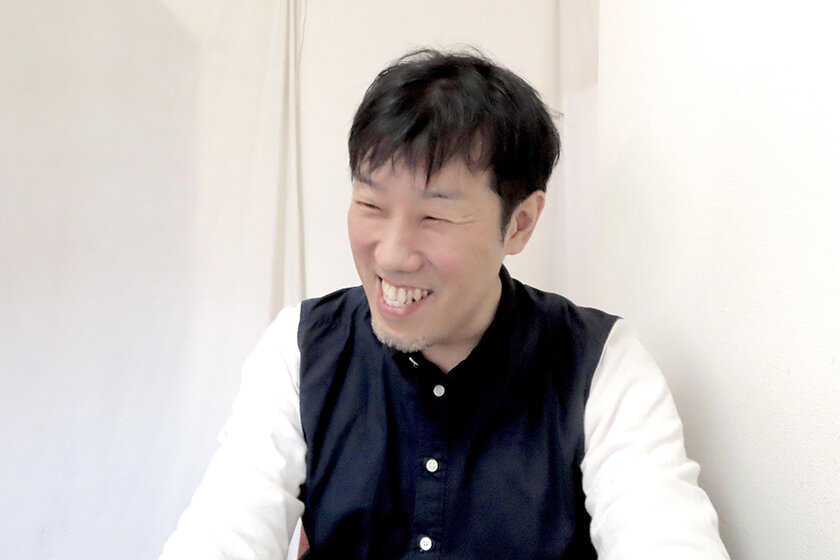
Will the spotlight shine on introverted art in the pandemic?
Looking back now on the recent art scene, I see that the newest forms of art are interactive. They often involve viewer participation or are large-scale project types that challenge your communication skills and the ability to open up as an extrovert. Meanwhile, possibly because I spend most of my time making tiny things by myself, I really don't like holding workshops and such. Once before, I thought of holding a workshop where participants could make something the way I made things, but I was told "there's no way normal people are going to manage that!" I have a kind of "traditional craftsman" attitude, so I sometimes envy artists with the communication skills to create work that involves a multitude of participants.
On the other hand, I have a suspicion that if the pandemic is going to result in any changes for the future, artwork by people like me who coop themselves up in studios to work alone might gain renewed recognition. I'm sure that of the many students studying at art universities today, there are some who don't really like doing interactive projects but feel like they have to. But the pandemic has inadvertently created a situation where all students stay at home, unable to take classes in the same environment and using online resources to do the best they can in their homes. It's a situation that's bound to make them rediscover inspiration from their immediate surroundings. I guess having the focus on that kind of thing is new, in a way.
That's why I have a feeling that these remote environments will give rise to artwork with a sense of solitude, which would be interesting to see. The job of an artist is to continue making more art, no matter what. I'm sure people who did interactive projects before will find even more complicated ways of expressing interpersonal connections, making use of things like the internet and VR. I hope to see diversity in artwork expand in ways that are different from before.
Taking a look at the art "tucked away" in Roppongi
I'm usually busy looking at the history of a location in order to make art, but sometimes when I take a look around an area without work on my mind, I realize something. I don't really know what happens to my pieces once they get sold. The only examples I can think of are when a person showed me some iPhone photos of one of my toothbrush pieces displayed in their bathroom, and when I got a private invitation from someone who created a personal display space for my work. I think it would be very interesting to know how the pieces sold to collectors are being displayed or stored away.
Toothbrush pieces
A segment of the Out of Disorder series entitled "bush." A delicate steel lattice tower stretches out from the bristles of each toothbrush.
Out of Disorder (bush)
2015
Photo: Fuyumi Murata
©Takahiro Iwasaki, Courtesy of ANOMALY
I think there are a lot of art collectors in Roppongi, so I would love to take a tour of their offices and homes to see what kind of artwork they have bought and how they are displaying them. Actually, there was a time before in New York where I participated in an annual event that takes a look at collector's homes, and I made a lot of discoveries. For example, seeing a painting in a museum doesn't make it feel very tangible as an object because it's in such a huge space, but when a painting is hung up on the wall of a home or an office, it looks so much cooler. It makes me realize that it's actually something one can buy and that I might want it, too.
I'm on the making end of art, so I never really understood what it was like to be a collector. That was the first time I thought it might be nice to not just make art but to display it as well, to add some zest to everyday life (laughs). I think a tour like that would be fun to do outside of Tokyo, too. If you think of the tokonoma alcove in a traditional Japanese home as a kind of private gallery, Japanese people have always had a gallery space in their homes. What kind of art is privately tucked away in the district of Roppongi? I would love to see some droolworthy possessions, curious or otherwise. I really wonder what kind of things IT people buy and enjoy these days.
Editor's thoughts
Before the coronavirus pandemic, Tokyo had the highest population influx in all of Japan, but right now, that trend is starting to change. Being based in Hiroshima, Iwasaki-san must see the city of Tokyo in a different way compared to those who live in and are based in Tokyo. His perspective gives us fresh surprises by visualizing the unnoticed realities we take for granted with a change in distance or scale. Now that we have all been forced to a standstill, it is precisely the time for us to put our heads together to build a new future. Iwasaki-san's insight has taught me that now is the perfect time for us to "scrap and build."(text_ikuko hyodo)
(The images here were taken during our online interview.)
RANKING
ALL
CATEGORY




